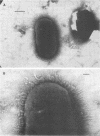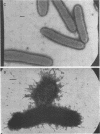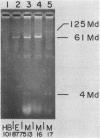Abstract
PCF8775 is a putative colonization factor complex present on the surface of 10 to 20% of enterotoxigenic Escherichia coli strains and has been reported to be composed of antigen CS6 (morphology undefined) expressed alone or together with either of the rigid fimbrial antigens CS4 and CS5. To better define the individual components of this complex and the determinants of their expression, we prepared antiserum to the PCF8775 complex as it was expressed on prototype strain E8775 and then used the antiserum to identify the subunit structure of the antigens, to study their morphology, and to detect expression of individual components of the complex after transfer of plasmids into laboratory strain HB101. CS4 was purified from strain E8775, confirmed to be fimbrial by electron microscopy, and found to be composed of a 22-kilodalton protein subunit whose N-terminal amino acid sequence (1 to 20) was similar to that of colonization factor antigen I. Transconjugants that express CS6 but not CS4 were obtained by mating prototype strain E8775 with HB101. CS6 expression was mediated by a 61-megadalton plasmid. Expression of CS6 in the transconjugants correlates with expression of a 16-kilodalton cell surface protein. The CS6 antigen was confirmed to be present on the cell surface by immunogold labeling, but its morphology was beyond the limits of resolution by electron microscopy.
Full text
PDF



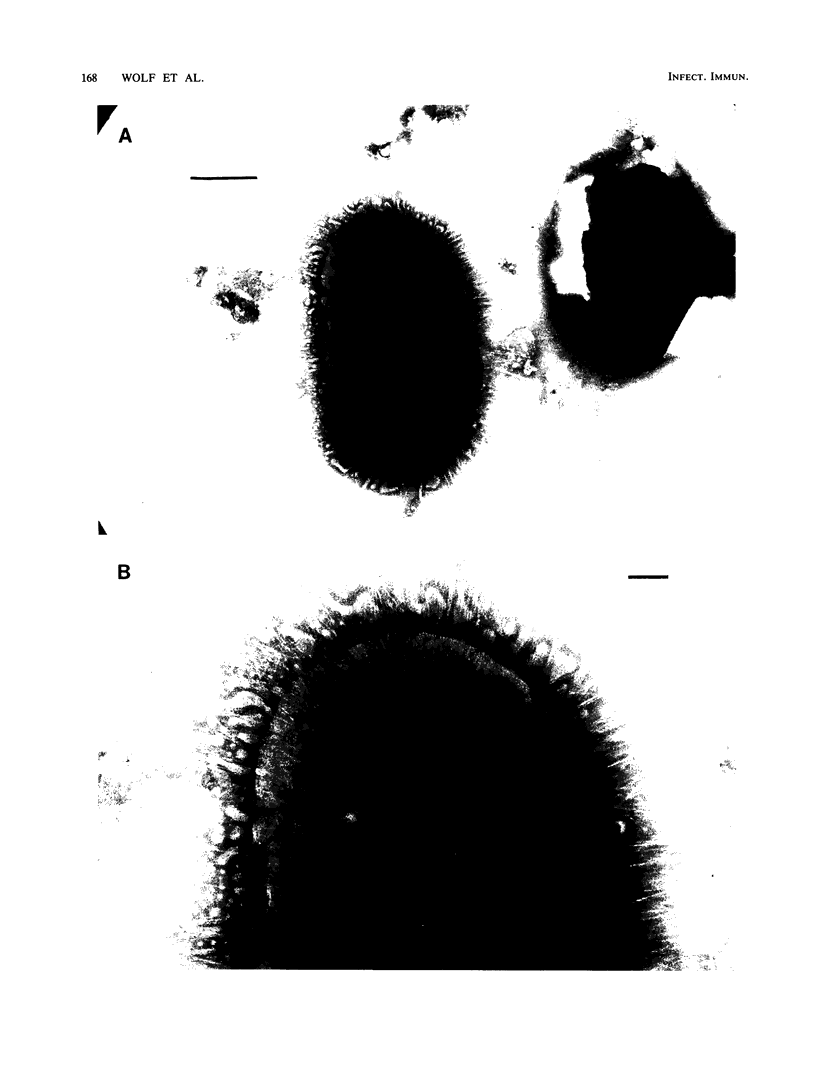
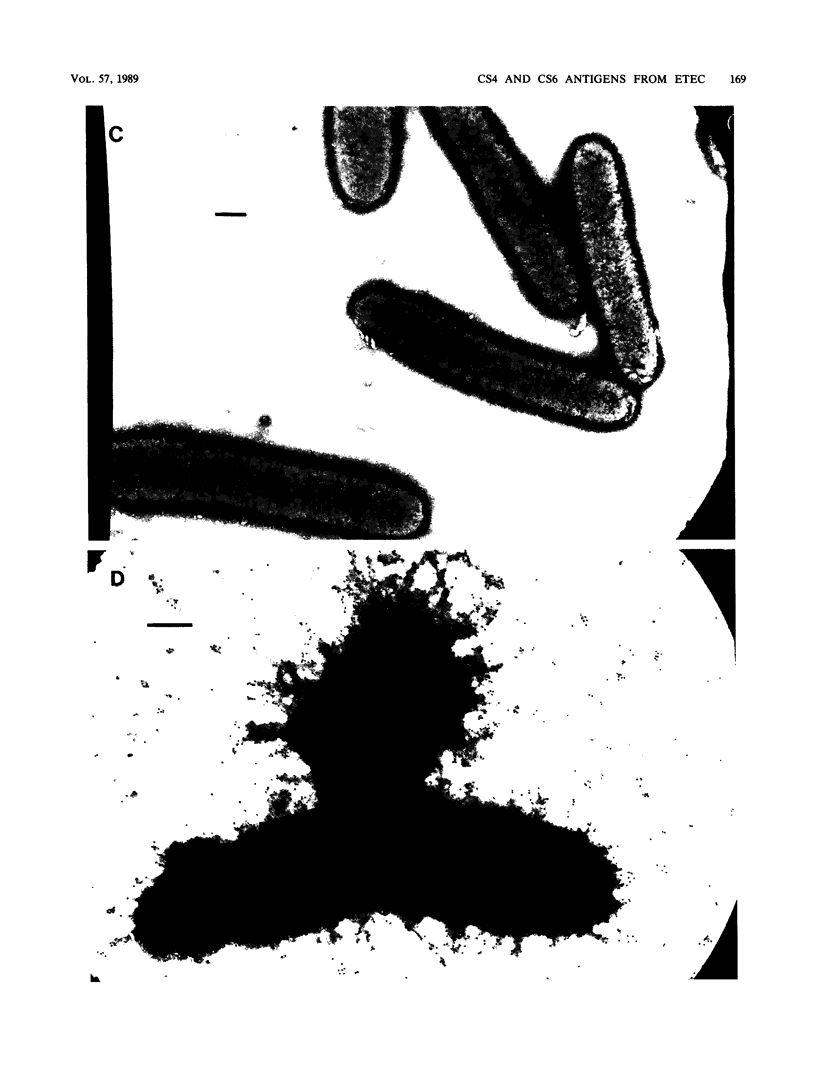

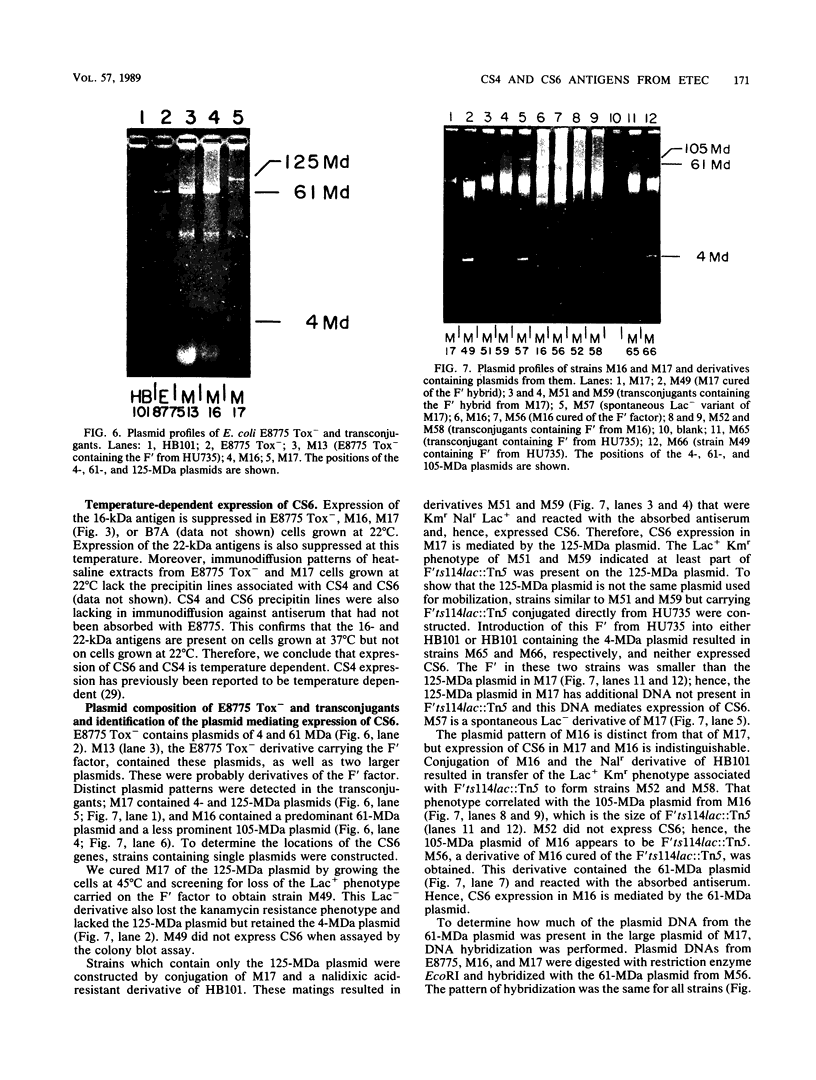
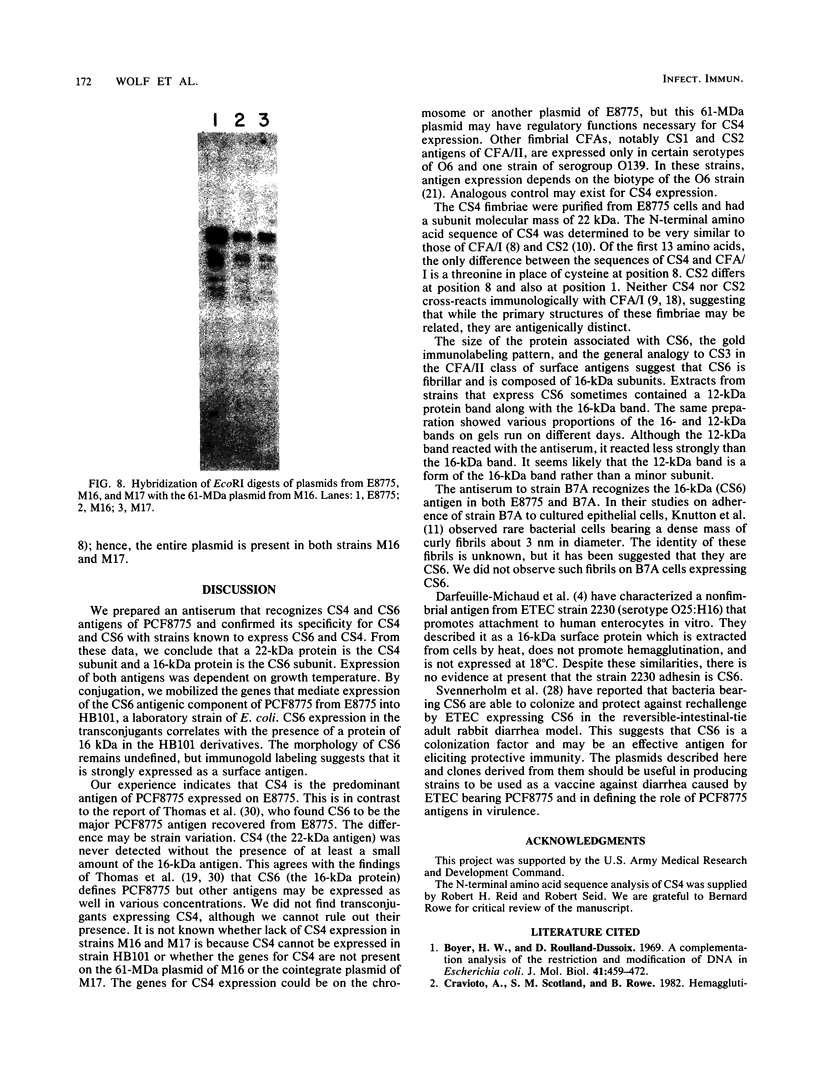
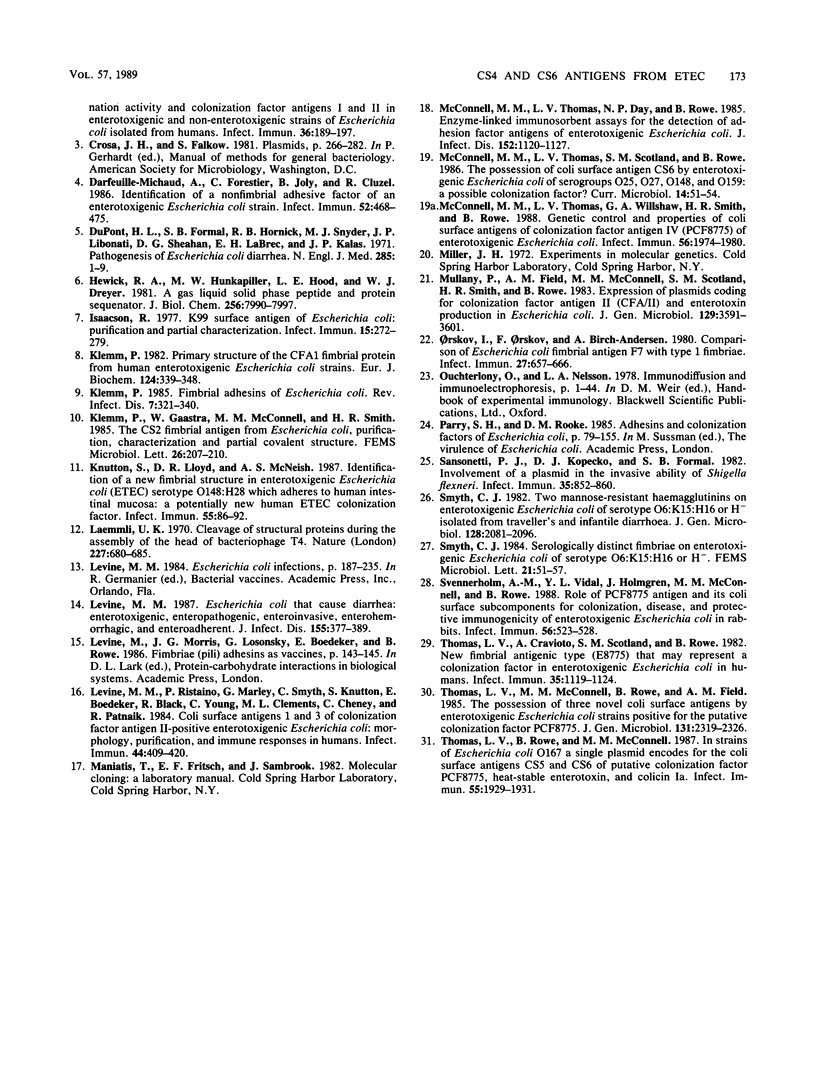
Images in this article
Selected References
These references are in PubMed. This may not be the complete list of references from this article.
- Boyer H. W., Roulland-Dussoix D. A complementation analysis of the restriction and modification of DNA in Escherichia coli. J Mol Biol. 1969 May 14;41(3):459–472. doi: 10.1016/0022-2836(69)90288-5. [DOI] [PubMed] [Google Scholar]
- Cravioto A., Scotland S. M., Rowe B. Hemagglutination activity and colonization factor antigens I and II in enterotoxigenic and non-enterotoxigenic strains of Escherichia coli isolated from humans. Infect Immun. 1982 Apr;36(1):189–197. doi: 10.1128/iai.36.1.189-197.1982. [DOI] [PMC free article] [PubMed] [Google Scholar]
- Darfeuille-Michaud A., Forestier C., Joly B., Cluzel R. Identification of a nonfimbrial adhesive factor of an enterotoxigenic Escherichia coli strain. Infect Immun. 1986 May;52(2):468–475. doi: 10.1128/iai.52.2.468-475.1986. [DOI] [PMC free article] [PubMed] [Google Scholar]
- DuPont H. L., Formal S. B., Hornick R. B., Snyder M. J., Libonati J. P., Sheahan D. G., LaBrec E. H., Kalas J. P. Pathogenesis of Escherichia coli diarrhea. N Engl J Med. 1971 Jul 1;285(1):1–9. doi: 10.1056/NEJM197107012850101. [DOI] [PubMed] [Google Scholar]
- Hewick R. M., Hunkapiller M. W., Hood L. E., Dreyer W. J. A gas-liquid solid phase peptide and protein sequenator. J Biol Chem. 1981 Aug 10;256(15):7990–7997. [PubMed] [Google Scholar]
- Isaacson R. E. K99 surface antigen of Escherichia coli: purification and partial characterization. Infect Immun. 1977 Jan;15(1):272–279. doi: 10.1128/iai.15.1.272-279.1977. [DOI] [PMC free article] [PubMed] [Google Scholar]
- Klemm P. Fimbrial adhesions of Escherichia coli. Rev Infect Dis. 1985 May-Jun;7(3):321–340. doi: 10.1093/clinids/7.3.321. [DOI] [PubMed] [Google Scholar]
- Klemm P. Primary structure of the CFA1 fimbrial protein from human enterotoxigenic Escherichia coli strains. Eur J Biochem. 1982 May 17;124(2):339–348. doi: 10.1111/j.1432-1033.1982.tb06597.x. [DOI] [PubMed] [Google Scholar]
- Knutton S., Lloyd D. R., McNeish A. S. Identification of a new fimbrial structure in enterotoxigenic Escherichia coli (ETEC) serotype O148:H28 which adheres to human intestinal mucosa: a potentially new human ETEC colonization factor. Infect Immun. 1987 Jan;55(1):86–92. doi: 10.1128/iai.55.1.86-92.1987. [DOI] [PMC free article] [PubMed] [Google Scholar]
- Laemmli U. K. Cleavage of structural proteins during the assembly of the head of bacteriophage T4. Nature. 1970 Aug 15;227(5259):680–685. doi: 10.1038/227680a0. [DOI] [PubMed] [Google Scholar]
- Levine M. M. Escherichia coli that cause diarrhea: enterotoxigenic, enteropathogenic, enteroinvasive, enterohemorrhagic, and enteroadherent. J Infect Dis. 1987 Mar;155(3):377–389. doi: 10.1093/infdis/155.3.377. [DOI] [PubMed] [Google Scholar]
- Levine M. M., Ristaino P., Marley G., Smyth C., Knutton S., Boedeker E., Black R., Young C., Clements M. L., Cheney C. Coli surface antigens 1 and 3 of colonization factor antigen II-positive enterotoxigenic Escherichia coli: morphology, purification, and immune responses in humans. Infect Immun. 1984 May;44(2):409–420. doi: 10.1128/iai.44.2.409-420.1984. [DOI] [PMC free article] [PubMed] [Google Scholar]
- McConnell M. M., Thomas L. V., Day N. P., Rowe B. Enzyme-linked immunosorbent assays for the detection of adhesion factor antigens of enterotoxigenic Escherichia coli. J Infect Dis. 1985 Dec;152(6):1120–1127. doi: 10.1093/infdis/152.6.1120. [DOI] [PubMed] [Google Scholar]
- McConnell M. M., Thomas L. V., Willshaw G. A., Smith H. R., Rowe B. Genetic control and properties of coli surface antigens of colonization factor antigen IV (PCF8775) of enterotoxigenic Escherichia coli. Infect Immun. 1988 Aug;56(8):1974–1980. doi: 10.1128/iai.56.8.1974-1980.1988. [DOI] [PMC free article] [PubMed] [Google Scholar]
- Mullany P., Field A. M., McConnell M. M., Scotland S. M., Smith H. R., Rowe B. Expression of plasmids coding for colonization factor antigen II (CFA/II) and enterotoxin production in Escherichia coli. J Gen Microbiol. 1983 Dec;129(12):3591–3601. doi: 10.1099/00221287-129-12-3591. [DOI] [PubMed] [Google Scholar]
- Orskov I., Orskov F., Birch-Andersen A. Comparison of Escherichia coli fimbrial antigen F7 with type 1 fimbriae. Infect Immun. 1980 Feb;27(2):657–666. doi: 10.1128/iai.27.2.657-666.1980. [DOI] [PMC free article] [PubMed] [Google Scholar]
- Sansonetti P. J., Kopecko D. J., Formal S. B. Involvement of a plasmid in the invasive ability of Shigella flexneri. Infect Immun. 1982 Mar;35(3):852–860. doi: 10.1128/iai.35.3.852-860.1982. [DOI] [PMC free article] [PubMed] [Google Scholar]
- Smyth C. J. Two mannose-resistant haemagglutinins on enterotoxigenic Escherichia coli of serotype O6:K15:H16 or H-isolated from travellers' and infantile diarrhoea. J Gen Microbiol. 1982 Sep;128(9):2081–2096. doi: 10.1099/00221287-128-9-2081. [DOI] [PubMed] [Google Scholar]
- Svennerholm A. M., Vidal Y. L., Holmgren J., McConnell M. M., Rowe B. Role of PCF8775 antigen and its coli surface subcomponents for colonization, disease, and protective immunogenicity of enterotoxigenic Escherichia coli in rabbits. Infect Immun. 1988 Feb;56(2):523–528. doi: 10.1128/iai.56.2.523-528.1988. [DOI] [PMC free article] [PubMed] [Google Scholar]
- Thomas L. V., Cravioto A., Scotland S. M., Rowe B. New fimbrial antigenic type (E8775) that may represent a colonization factor in enterotoxigenic Escherichia coli in humans. Infect Immun. 1982 Mar;35(3):1119–1124. doi: 10.1128/iai.35.3.1119-1124.1982. [DOI] [PMC free article] [PubMed] [Google Scholar]
- Thomas L. V., McConnell M. M., Rowe B., Field A. M. The possession of three novel coli surface antigens by enterotoxigenic Escherichia coli strains positive for the putative colonization factor PCF8775. J Gen Microbiol. 1985 Sep;131(9):2319–2326. doi: 10.1099/00221287-131-9-2319. [DOI] [PubMed] [Google Scholar]
- Thomas L. V., Rowe B., McConnell M. M. In strains of Escherichia coli O167 a single plasmid encodes for the coli surface antigens CS5 and CS6 of putative colonization factor PCF8775, heat-stable enterotoxin, and colicin Ia. Infect Immun. 1987 Aug;55(8):1929–1931. doi: 10.1128/iai.55.8.1929-1931.1987. [DOI] [PMC free article] [PubMed] [Google Scholar]






